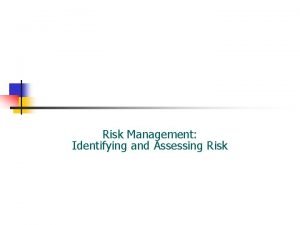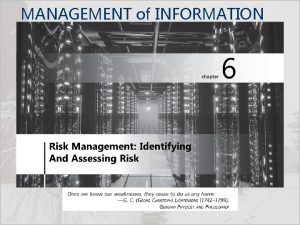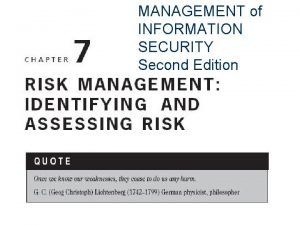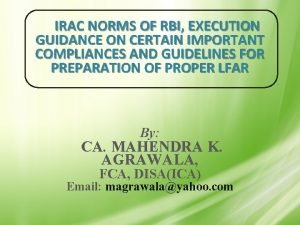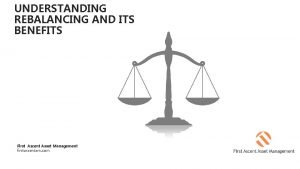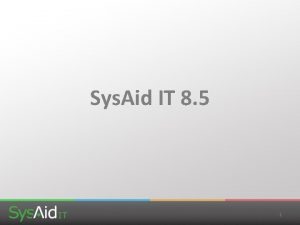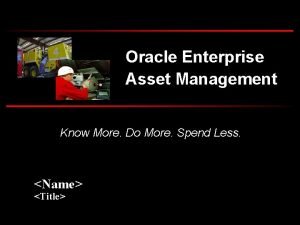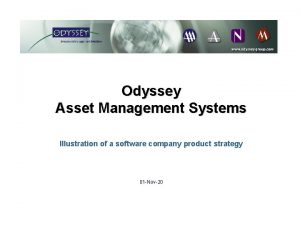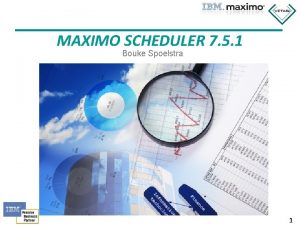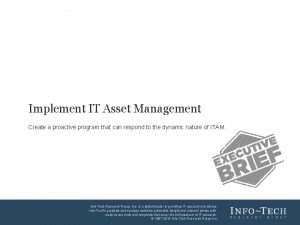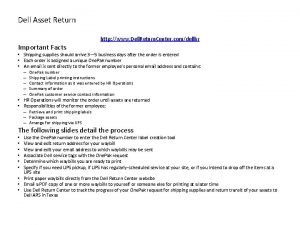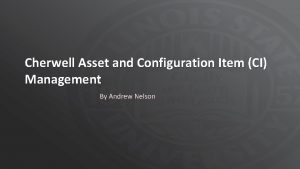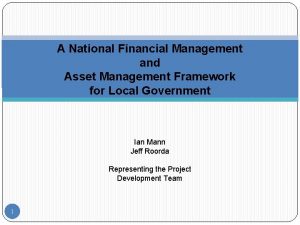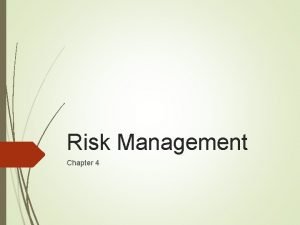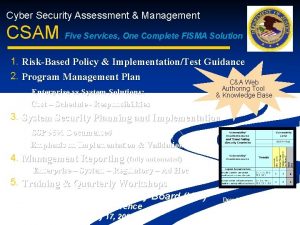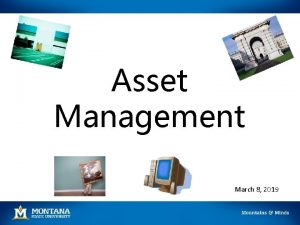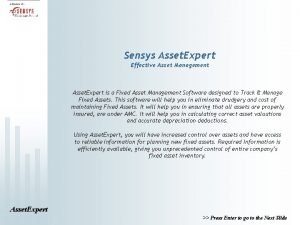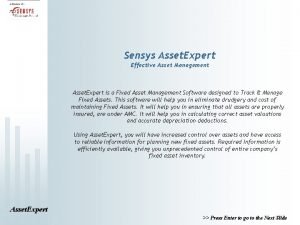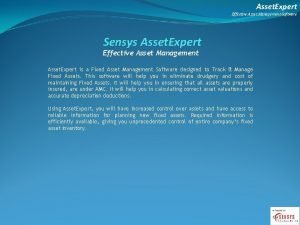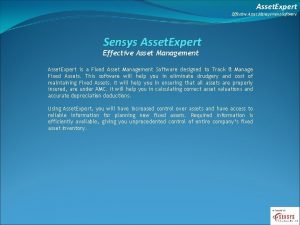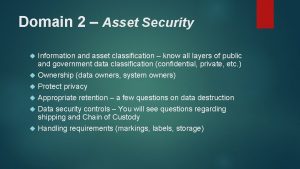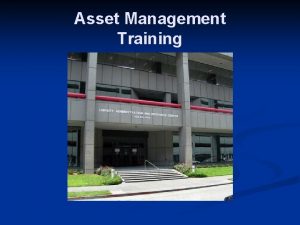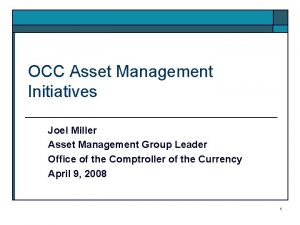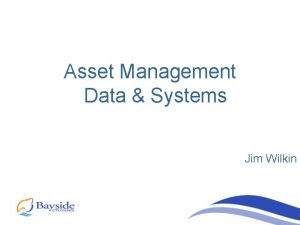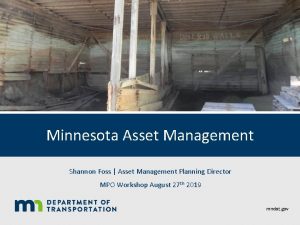Asset Management March 8 2019 Asset Classification 1
































- Slides: 32

Asset Management March 8, 2019

Asset Classification 1. Capital Assets • • Cost greater than $5, 000 Use an expense account code 63 xxx 2. Minor Equipment • • Cost greater than $1, 000 but less than $5, 000 Use expense account code 62238 3. Sensitive Equipment • Cost greater than $100 but less than $5, 000 • Items at greater risk of theft such as laptops, tablets, i. Pads, i. Pods, cell phones, cameras, microscopes, guns, artwork, televisions, musical instruments, etc.

Defining Capital Assets • Unit cost of $5, 000 or more – What makes up the cost? – Shipping, installation, shipping insurance, initial on-site installation and set up – Do NOT include: maintenance agreements, supplies • Complete in itself • Does not lose its identity even though it may become a component part of another item when placed in use • Life expectancy of 1 year or more

Donated Assets • All in-kind donations, regardless of value should be reported to Property Management • In-kind donations with value of >$5, 000 are assigned a tag number and tracked by PM • If solicited by MSU and valued in excess of $5, 000, the Alumni Foundation must be notified of the donation • Appraisal of capital donations from an independent party is needed for IRS purposes • $1, 000 -$4, 999 should be added to minor inventory lists and tracked by Department • Policies listed at http: //www. montana. edu/policy/gifts/

ITF (Intent to Fabricate) • The purchase of smaller pieces of equipment / parts that will be built into an asset with a value of at least $5, 000 • Find the ITF form on the PM website. PM will use the information from the form to track all purchases related to the build. It should be submitted prior to purchases being made so an asset tag # can be assigned and included on all BPAs and Pcard invoices documentation • Asset tag # will be assigned, but asset will not show on dept capital inventory until substantially complete • PM will contact dept at FYE for updates regarding substantially complete/in use date status

Roles & Responsibilities of Asset Management Procurement Services • • May assist with purchase of asset Gathers lease information Property Management Accounting • • • Adds capital asset to record keeping system, tags asset and makes changes to asset records as necessary Completes inventories of capital and federally owned assets bi-annually Completes audits of grants when requested by OSP Collects inventories of minor and sensitive equipment from departments annually Collects verification of departmental review of capital inventory listing annually Responsible for coordinating/managing disposal of ALL assets with replacement value greater than $25 (E-scrap and Hazardous materials in collaboration with Safety & Risk) • • Records depreciation, Construction Work In Progress Reconciles all capital expenses (finance) to capital asset recording system (assets) Department • • • Reviews and reports to PM capital asset listing at least annually, more often if changes, additions, deletions are expected Notifies Property Management of any changes for capital assets (location, contact, ORG changes) Assists Property Management with access to capital items during physical inventory Maintains inventory of minor and sensitive equipment Completes and submits PARR form for disposal of any asset with replacement value greater than $25

Why is it important to review your departmental capital asset listing? • Asset Control – Where is the item located? – If not located, where did it go? Sold? Theft? Relocated? Trash? – PM staff required by state law to physically see the asset at least every 2 years. Location updates and contact changes from department help in this process. – All departments will be required to submit verification of their capital property lists to PM by April 26 th, 2019 • Subject to Legislative Audit Review – State auditors may come to your department to verify physical existence of an asset. – If it is on your list, you need to know where it is when the auditor wants to see it! – We are required to account for the existence and protection of all MSU assets, even those that are fully depreciated; adequate internal control processes • Financial Statement Ramifications – Incorrect inventory listing may mean our assets are misstated – Financial audit findings are reported to President, OCHE and Legislative Committee

Minor & Sensitive Equipment Inventory All departments will be required to submit their minor property lists to PM by April 26 th, 2019 At a minimum, your listing should contain the following information: – – – – Equipment Tag # (assigned by Dept) Description of item Make/Model Serial # (or other identifying #) Value/Purchase price Date acquired Location (building, room #) Contact/responsible party Property Management has tags with a fillable number field available for departmental use.


MSU Box for Capital Reports • Montana State Box • For login and other instructions please visit: www. montana. edu/box. • Access your Montana State Box account here: https: //montana. box. com • For access to capital reports, email Christina at Fournier@montana. edu

Secondary Tagging • Radio Frequency Identification (RFID) – The system uses passive RFID technology • The RFID tag only transmits a signal to the RFID reader • No signal is generated unless the tag is ‘speaking’ to a nearby reader • Barcode, rather than RFID, tags will be used on any sensitive equipment. We do not anticipate any issues or interference with most capital equipment; however barcode tags will be used on those pieces that are unable to utilize the RFID technology.

Surplus Property/Disposals Starts with a PARR form: Applies to any item on campus with a value greater than $25 Disposal can mean: sales, cannibalization, junk/broken, transfers (internal and external), trade-in

Surplus Property/Disposals An index number must be included when you submit the form. If PM is taking your items to our storage you will not be charged. If the item is to be recycled, Facilities will charge your index for the disposal.


Surplus Property/Disposals • New PARR form generates a helpdesk ticket, similar to what UIT Helpdesk uses • You will receive an email confirmation that your ticket has been submitted • Property Management will use the ‘notes’ function to keep you informed on the progress of your request • Property Management will code your request as ‘resolved’ once E-scrap or Facilities has been notified. Please do not respond ‘no’. Wait until the asset has been removed/relocated, then confirm ‘yes’. PM has no way of tracking E-scrap or Facilities work order progress. Your confirmation ‘yes’ will close the ticket.


Dealing with Transfers of Capital • Transfers between departments – Department getting rid of item completes the PARR form – Property Management will make the org change to the asset in the system • Transfer caused by Professor/PI leaving MSU for another university – Contact Property Management. New process is being developed and will be communicated by OSP soon – Items on a grant may be transferred if OSP approves – Most MSU owned assets will not transfer, that includes items purchased with IDC funds

Dealing with Trade - Ins • Complete PARR form, choosing ‘trade-in capital asset’ from drop down list • Send a copy of invoice, showing the transfer credit to Property Management for deletion of asset • Make note of transfer on new purchase paperwork (BPA or Pcard). Invoice should show transfer credit. • Not allowed for vehicles

Property Management Surplus Items are retained for MSU redistribution for at least a period of two weeks. Then they become available to other state agencies, schools, charitable organizations, etc. before being available for public sale.


Surplus FAQs • We don’t need this office chair/filing cabinet/ bookcase anymore. Can someone from the office/a student/the PI take it home? ØNo. All MSU assets must be offered for another business purpose before they are made available for sale/giveaway to anyone for personal use. Some items with a high demand on campus are held for longer periods of time.

Surplus FAQs • This computer equipment is still good, we just don’t want it. Are you just going to throw it away? ØNo. The E-scrap program also looks to redistribute computer equipment that is still functional and useful.

Surplus FAQs • I sent my PARR form in yesterday. When are you coming to take this stuff? Ø Property Management will contact you to make arrangements to view the item(s), to decide if it is something that will be kept for surplus or recycled. PM will contact Facilities Services to have the item removed, either to our storage units or to recycling. PM is not permitted to remove items from departments. And please remember we are only a staff of 2! If you know you need to free the space quickly (to accommodate delivery of new furniture, for example) please note that on the PARR form. We will make every effort to work with your schedule.

Surplus FAQs • How much is this going to cost my department to remove surplus items? ØFacilities Services bills at an hourly rate. Charges depend on the number of items moved, but usually the charges are minimal. If you have a larger number of items to move, you can contact Facilities directly for an estimate.

Surplus FAQs • How does my department get surplus? ØSee something you like on the surplus website? Call or email Property Management! We can meet you at storage to look at items in person. Facilities Services must move most items to your campus location.

Surplus FAQs • We have some specialized lab equipment that is still pretty valuable and we’d like to sell it ourselves. Can we do that? Ø Yes, but. . . A PARR form is still required and must be approved by PM before any sale arrangements are made. Property Management will work with you to determine the best means to sell (state auction site, MSU website, your contacts with potential interested parties). PM requires a copy of the sales receipt to include with the disposal records and a special revenue account code (53985) must be used to record the proceeds from the sale in Banner.

Find more info here: Visit our website: http: //www. montana. edu/ubs/propertymanagement/index. html Office of Audit Services Information available at http: //www. montana. edu/audit/guidance. html

E-scrap info here: Visit the website: http: //www. montana. edu/wwwsrm/escrap/index. html

Relocation Information Relocating a department requires the coordinated efforts of several MSU support areas. Office of Facility Services: Work Control, 994 -2107 Logun Norris, Recycling Coordinator, 994 -6871, logunnorris@montana. edu Sustainability & Recycling: Sustainability Office, 994 -6873, asmsusustain@montana. edu

Contact Information Property Management: Kristin Harbuck, 994 -5504 Kristin. Harbuck@montana. edu Zachary Martinez, 994 -2643 zacharymartinez@montana. edu Property Management Supervisor/General UBS questions: Christina Fournier, Financial Manager, 994 -3653 Fournier@montana. edu or UBSHelp@montana. edu E-scrap Coordinator: Shay Halverson, 994 -5678 shalverson@montana. edu

Upcoming! • Year-End Information - due to PM by April 26 th – Annual capital inventory verification – Minor/Sensitive inventory submission

 Anthem of poland
Anthem of poland Grihalakshmi magazine march 2019
Grihalakshmi magazine march 2019 Game data crunch
Game data crunch Asset management vs project management
Asset management vs project management Weighted factor analysis worksheet
Weighted factor analysis worksheet Tva worksheet
Tva worksheet Concentration risk
Concentration risk Information asset classification worksheet
Information asset classification worksheet Classification of advances as per rbi
Classification of advances as per rbi Ascent
Ascent Tivoli maximo
Tivoli maximo Social media marketing for asset managers
Social media marketing for asset managers Unity
Unity Sysaid it asset management
Sysaid it asset management Roof asset management software
Roof asset management software Pensum forsikringsmegling
Pensum forsikringsmegling Enterprise asset management oracle
Enterprise asset management oracle Triple a portfolio management software
Triple a portfolio management software Maximo asset management scheduler
Maximo asset management scheduler Premier asset management vision
Premier asset management vision It asset management sop
It asset management sop Sap asset management process flow
Sap asset management process flow Dell asset management tool
Dell asset management tool Itemcı
Itemcı Who owns brookfield asset management
Who owns brookfield asset management Automate asset management
Automate asset management National asset management assessment framework
National asset management assessment framework Software asset management microsoft
Software asset management microsoft Ranked vulnerability risk worksheet
Ranked vulnerability risk worksheet Infrastructure and asset management
Infrastructure and asset management Lawrence park credit strategies fund
Lawrence park credit strategies fund Industrial asset management llc
Industrial asset management llc Csam doj
Csam doj




